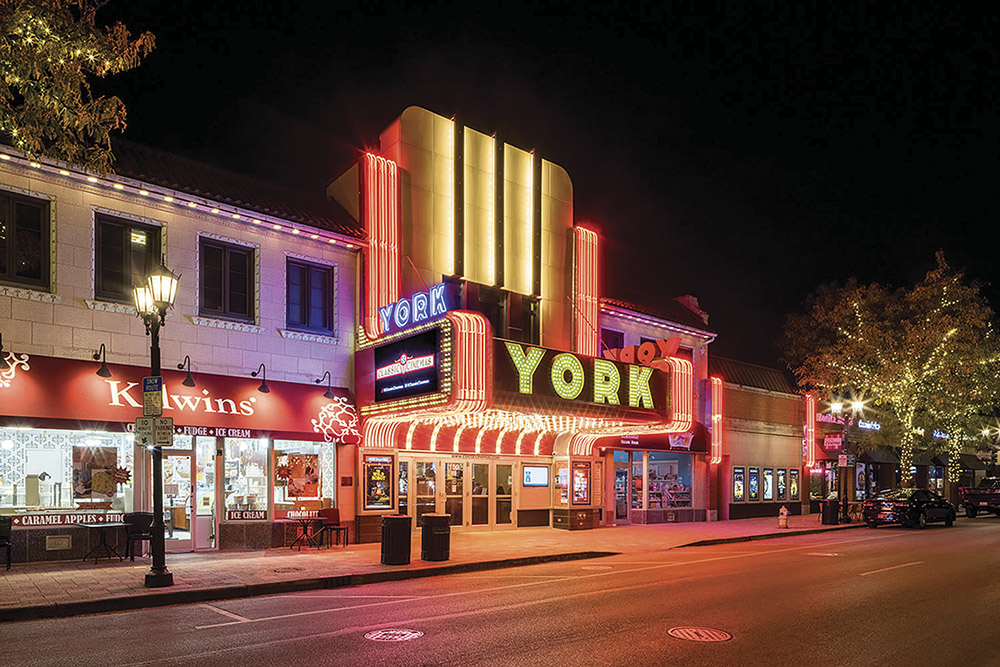100 Years of Movie Magic: Chris Johnson & York Theatre

York Theater celebrates 100 years!
By Maureen Callahan
Every story starts somewhere. For Elmhurst’s York Theater, that beginning was Labor Day weekend, 1924. The Roaring Twenties were in full swing. Downtown Elmhurst saw its second theater open (the first was The Elms on W. First St.). It was a much bigger theater than The Elms, with seating for 1,000. The Elms closed within a year.
Ten decades later, The York has seen hard times come and go through town. It has stood the test of economics, shifts in the entertainment industry, and the remaking of the community in which it stands.
Elmhurst held a birthday celebration for the centurion theater over Labor Day Weekend. Local historian and Downers Grove resident Jim Toth presented a screening of York 100, an entertaining look at the theater through the ages.
An organist tickled the keys of an antique organ and treated guests to a mini concert, showcasing the importance of the organ in early movie houses to the film. The music sparked a memory with attendee Duane Stevenson, who had come out that day with his daughter, Debbie Martin. Stevenson knew York’s first organist from childhood. Now 101 years old, he was the only member of the crowd alive when the theater opened. “I came often with friends,” Stevenson smiled as he recalled. “I saw so many movies here. We always loved the shorts before the movies. They were newsreels back then.”
Joyce Erickson Sloan and Judy DuBois Brown came out to the celebration as well. The two met at The York, behind the candy counter, 60 years ago and became lifelong friends. As concession girls, they sold the ‘expensive stuff’ behind the candy counter, as there was also a nickel candy machine with Lemonheads and the like nearby. Sloan graduated from York High in the Class of 1966, and Brown graduated from IC in the Class of 1967. “There was a good mix of employees from both schools,” said Sloan.
“We worked together every Saturday from noon-4, but whenever someone didn’t show up, we stayed for the second shift,” said Sloan. “So, we spent a lot of time together.” At $0.89 an hour, it was one of the higher paying jobs in town for high school kids. “You got a 15-minute break every so often, and you would watch some of whatever movie was playing,” said Brown. “After several shifts, you had seen the whole thing, but not necessarily in order,” she said as she laughed. “I probably saw West Side Story 20 times!”
The pair reminisced about the shenanigans the workers played on one another. “There was a small door next to the stage we had to walk under to get more ice cream if we ran out of it at the counter,” said Brown. “You had to go through a pitch-black space to get it. The ushers would wait there to scare us!” They also recalled fielding many complaints when the popcorn counter went from oil to butter. “So many great memories,” said Sloan. “After all these years, York is still our theater of choice.”
York 100 takes viewers through Labor Day Weekend, 1924, to the present day. The theater was designed by architect Elmer Behrens in a Spanish Revival style. This look, while prevalent in the 1920s, was anything but common. Behrens had also designed The Chicago Theater and The Tivoli Theater in Downers Grove. Like those venues, The York also had similar niches on its interior walls, contributing to an exotic, Mediterranean look.
As the documentary pointed out, one contributing factor to York’s greatest success was that it constantly evolved. The owners were willing to keep up with change. The first ‘talkie’- a movie with sound – was released in 1927. A little over a year later, talkie equipment was installed.
The late 30s brought lots of changes and updates for the theater. The current façade, considered cutting edge for that day, added an ‘art modern’ look, accompanied by neon lights, in 1937.
The 60s brought stiffer competition from shopping plazas, particularly Oakbrook Center, which offered cinematic experiences as part of a trip to the mall. The entire downtown Elmhurst shopping district, including The York, began to fall on hard times as it struggled to keep up with entertainment rivals. The theater began to fall into disrepair.
The York nearly closed its doors permanently in the 70s. It was closed for almost a year due to disrepair. The once-gorgeous, ornate plaster ceiling had to be removed. Second-run shows began to headline. The whole business district felt The York’s demise, as diminishing crowds lessened at shops and restaurants as well.
Things looked up as the Johnson family purchased the theater in the early 80s. “I was an usher at the Tivoli in Downers Grove when my dad, Willis, and his wife, Shirley, decided to come to Elmhurst,” Chris Johnson, CEO of Classic Cinemas, said in the documentary. “I thought Elmhurst was nice but didn’t really understand its rich history and sense of community.” Johnson further elaborated that the theater was the family’s largest investment in the town. “It was so exciting to have the community embrace it at every turn,” Johnson acknowledged.
Many long stories come full circle. Once again, The York Theater is a bright, shining beacon – literally and figuratively – and an anchor of Elmhurst.
Visit classiccinemas.com for the latest showtimes.

The historic York Theatre was designed by noted theatre architect Elmer Behrens and opened on Labor Day, 1924.

York Theatre lights up York Street in downtown Elmhurst.
Photo by Jacob Hand

Classic Cinemas acquired the theatre in 1982.

CEO of Classic Cinemas
Chris Johnson at York Theatre
Photo by Victor Hilitski













